Top Rankings
Haakon School District 27-1 ranks among the top 20% of public school district in South Dakota for:
Category
Attribute
Science Proficiency
Highest science proficiency (Top 5%)
For the 2025 school year, there are 4 public schools serving 322 students in Haakon School District 27-1. This district's average testing ranking is 5/10, which is in the bottom 50% of public schools in South Dakota.
Public Schools in Haakon School District 27-1 have an average math proficiency score of 42% (versus the South Dakota public school average of 43%), and reading proficiency score of 51% (versus the 51% statewide average).
Minority enrollment is 9% of the student body (majority American Indian and Hispanic), which is less than the South Dakota public school average of 33% (majority American Indian).
Overview
This School District
This State (SD)
# Schools
4 Schools
734 Schools
# Students
322 Students
146,041 Students
# Teachers
23 Teachers
10,645 Teachers
Student : Teacher Ratio
14:1
14:1
District Rank
Haakon School District 27-1, which is ranked within the bottom 50% of all 146 school districts in South Dakota (based off of combined math and reading proficiency testing data) for the 2021-2022 school year.
The school district's graduation rate of 80% has stayed relatively flat over five school years.
Overall District Rank
#69 out of 148 school districts
(Top 50%)
(Top 50%)
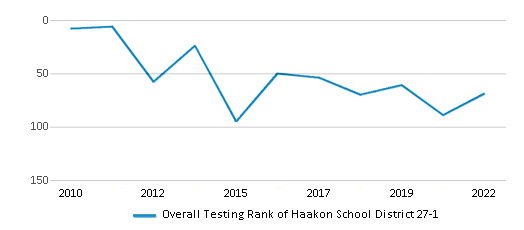
Math Test Scores (% Proficient)
40-44%
42%
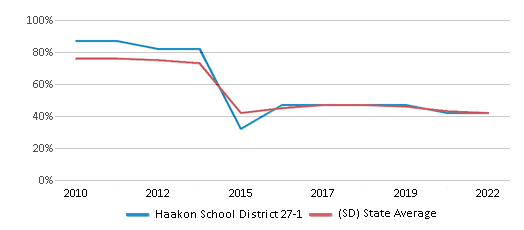
Reading/Language Arts Test Scores (% Proficient)
50-54%
51%
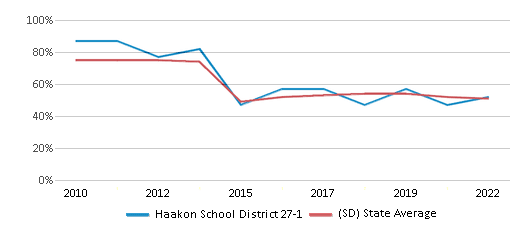
Science Test Scores (% Proficient)
55-59%
42%

Graduation Rate
≥80%
82%
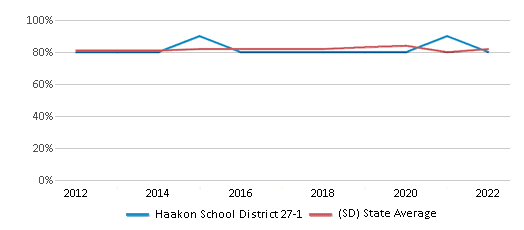
Students by Ethnicity:
Diversity Score
0.18
0.53
# American Indian Students
5 Students
20,873 Students
% American Indian Students
1%
14%
# Asian Students
2 Students
2,252 Students
% Asian Students
1%
2%
# Hispanic Students
3 Students
11,917 Students
% Hispanic Students
1%
8%
# Black Students
1 Student
4,730 Students
% Black Students
n/a
3%
# White Students
292 Students
97,780 Students
% White Students
91%
67%
# Hawaiian Students
1 Student
197 Students
% Hawaiian Students
n/a
n/a
# Two or more races Students
18 Students
8,292 Students
% of Two or more races Students
6%
6%
Students by Grade:
# Students in PK Grade:
-
3,175
# Students in K Grade:
24
11,936
# Students in 1st Grade:
30
10,796
# Students in 2nd Grade:
22
10,955
# Students in 3rd Grade:
26
10,445
# Students in 4th Grade:
18
10,671
# Students in 5th Grade:
20
10,790
# Students in 6th Grade:
24
10,961
# Students in 7th Grade:
26
11,058
# Students in 8th Grade:
32
11,237
# Students in 9th Grade:
21
12,230
# Students in 10th Grade:
28
11,381
# Students in 11th Grade:
23
10,546
# Students in 12th Grade:
28
9,860
# Ungraded Students:
-
-
District Revenue and Spending
The revenue/student of $14,646 is higher than the state median of $13,121. The school district revenue/student has stayed relatively flat over four school years.
The school district's spending/student of $12,006 is less than the state median of $12,623. The school district spending/student has stayed relatively flat over four school years.
Total Revenue
$5 MM
$1,916 MM
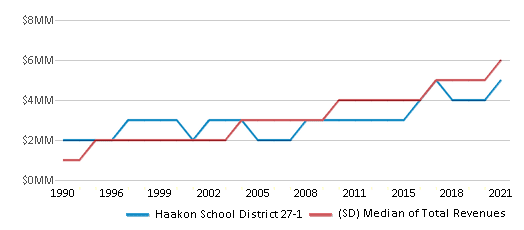
Spending
$4 MM
$1,844 MM

Revenue / Student
$14,646
$13,121
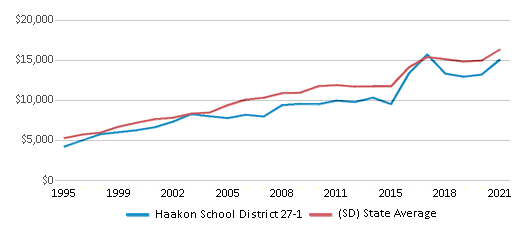
Spending / Student
$12,006
$12,623
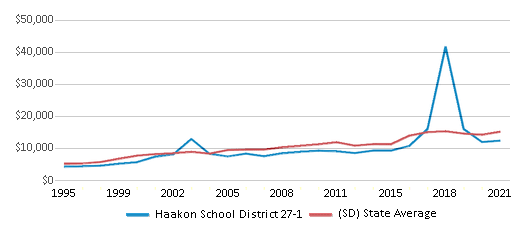
Best Haakon School District 27-1 Public Schools (2025)
School
(Math and Reading Proficiency)
(Math and Reading Proficiency)
Location
Grades
Students
Rank: #11.
Milesville Elementary - 08
(Math: <50% | Reading: ≥50%)
Rank:
Rank:
7/
Top 50%10
22053 Harding Grove Rd
Philip, SD 57567
(605) 859-2001
Philip, SD 57567
(605) 859-2001
Grades: K-8
| 17 students
Rank: #22.
Philip High School - 01
(Math: 21-39% | Reading: ≥80%)
Rank:
Rank:
6/
Top 50%10
330 Scottie Ave
Philip, SD 57567
(605) 859-2680
Philip, SD 57567
(605) 859-2680
Grades: 9-12
| 100 students
Rank: #33.
Philip Jr. High - 03
(Math: 40-49% | Reading: 50-59%)
Rank:
Rank:
5/
Bottom 50%10
330 Scottie Ave
Philip, SD 57567
(605) 859-2680
Philip, SD 57567
(605) 859-2680
Grades: 6-8
| 76 students
Rank: #44.
Philip Elementary - 02
(Math: 40-44% | Reading: 40-44%)
Rank:
Rank:
3/
Bottom 50%10
330 Scottie Ave
Philip, SD 57567
(605) 859-2001
Philip, SD 57567
(605) 859-2001
Grades: K-5
| 129 students
Frequently Asked Questions
How many schools belong to Haakon School District 27-1?
Haakon School District 27-1 manages 4 public schools serving 322 students.
What is the rank of Haakon School District 27-1?
Haakon School District 27-1 is ranked #82 out of 146 school districts in South Dakota (bottom 50%) based off of combined math and reading proficiency testing data for the 2021-2022 school year. This district ranks in the top 20% of South Dakota school districts for: Highest science proficiency (Top 5%)
What is the racial composition of students in Haakon School District 27-1?
91% of Haakon School District 27-1 students are White, 6% of students are Two or more races, 1% of students are American Indian, 1% of students are Asian, and 1% of students are Hispanic.
What is the student/teacher ratio of Haakon School District 27-1?
Haakon School District 27-1 has a student/teacher ratio of 14:1, which is equal to the South Dakota state average of 14:1.
What is Haakon School District 27-1's spending/student ratio?
The school district's spending/student of $12,006 is less than the state median of $12,623. The school district spending/student has stayed relatively flat over four school years.
Recent Articles

Year-Round Or Traditional Schedule?
Which is more appropriate for your child? A year-round attendance schedule or traditional schedule? We look at the pros and cons.

Why You Should Encourage Your Child to Join a Sports Team
Participating in team sports has a great many benefits for children, there is no doubt. In this article you will learn what those benefits are.

White Students are Now the Minority in U.S. Public Schools
Increasing birth rates among immigrant families from Asia and Central and South America, combined with lower birth rates among white families, means that for the first time in history, public school students in the United States are majority-minority. This shift in demographics poses difficulties for schools as they work to accommodate children of varying language abilities and socio-economic backgrounds.





